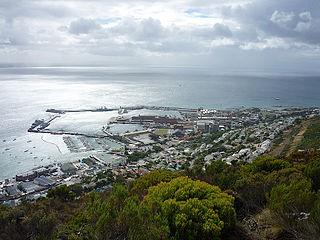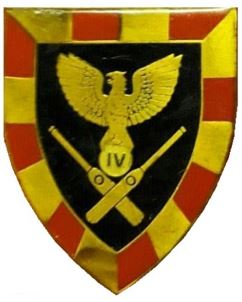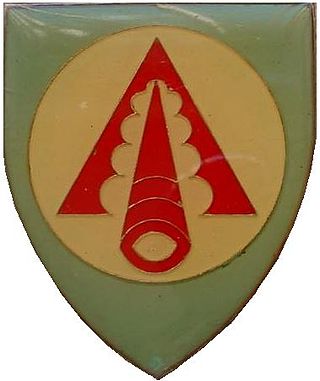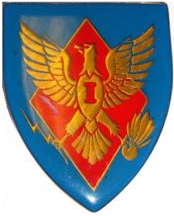
In military organizations, the practice of carrying colours, standards, flags, or guidons, both to act as a rallying point for troops and to mark the location of the commander, is thought to have originated in Ancient Egypt some 5,000 years ago. The Roman Empire also made battle standards reading SPQR a part of their vast armies. It was formalized in the armies of Europe in the High Middle Ages, with standards being emblazoned with the commander's coat of arms.

The Royal Regiment of Australian Artillery, normally referred to as the Royal Australian Artillery (RAA), is a Regiment of the Australian Army descended from the original colonial artillery units prior to Australia's federation. Australia's first guns were landed from HMS Sirius and a small earthen redoubt built, near the present-day Macquarie Place, to command the approaches to Sydney Cove. The deployment of these guns represents the origins of artillery in Australia. These and subsequent defences, as well as field guns, were operated by marines and the soldiers of infantry regiments stationed in Australia. Unlike their British and Canadian equivalents, there are no regiments of horse artillery in the order of battle of the Royal Australian Artillery. The First World War saw the raising of 60 field, 20 howitzer, and two siege batteries along with the heavy and medium trench mortar batteries. Until 19 September 1962 the Australian Artillery was referred to as the 'Royal Australian Artillery', however, on this date Queen Elizabeth II granted the RAA the title of 'The Royal Regiment of Australian Artillery'. The Regiment today consists of Regular and Reserve units.

The Sri Lanka Artillery (SLA) is the artillery arm of the Sri Lanka Army. It is made up of ten regular regiments and two volunteer regiments. The SLA is headquartered at Panagoda Cantonment, Panagoda.

The Sri Lanka Air Force Regiment is a specialized ground combat corps within the Sri Lanka Air Force, responsible for capturing and defending airfields and associated installations. Its members are the SLAF Regiment Officers and the airmen of operations ground specialization. The SLAF Regiment is fully capable of protecting all its air bases, installations by itself using infantry and light armored units as well as launch air assaults with Airborne Infantry elements (paratroopers). Ground-based air defense of vital military and civil installations around the country is carried out by the SLAF Regiment along with combat search and rescue missions (CSAR). The corps itself is simply known as the 'regiment'.

South Africa currently does not have a marine corps, though in the past it did. It was originally set up as a sub-branch of the South African Navy during the apartheid era, with the primary purpose of protecting the country's harbours (1951-1955). Then it was recreated in 1979 during the South African Border War as 1 Marine Brigade with the aim of serving as marine infantry (1979-1990). Today, the SAN Maritime Reaction Squadron is the closest analogue to a marine corps South Africa has.
Green Archer, also called Radar, Field Artillery, No 8 was a widely used British mortar locating radar operating in the X band using a Foster scanner. Developed by EMI after an experimental model by the Royal Radar Establishment, it was in British service from 1962 until 1975 with the Royal Artillery. A self-propelled version was designated FV436 or Radar, FA, No 8 Mk 2. It was replaced by Cymbeline starting in 1975.

Radar, Field Artillery, No 15, better known as Cymbeline, was a widely used British mortar locating radar operating in the I band using a Foster scanner. Developed by Thorn-EMI and built at their now-defunct site at Hayes in Middlesex, it was in British service from 1975 until about 2003 with the Royal Artillery.

44 Parachute Brigade was a parachute infantry brigade of the South African Army. It was founded on 20 April 1978, by Colonel Jan Breytenbach, following the disbandment of 1 SA Corps and the battle of Cassinga. Upon formation, the brigade was commanded by Brigadier M. J. du Plessis, who was assigned the task of establishing by working with the Parachute Staff Officer, Colonel Jan Breytenbach. At the time du Plessis was the commanding officer of the Orange Free State Command and had previous experience serving in 1 Parachute Battalion. Breytenbach had also been a member of 1 Parachute Battalion and had also founded the South African Special Forces Brigade and 32 Battalion. The location that was chosen for the brigade's headquarters was in the lines of the OFS Cmd Headquarters, next to the old Tempe Airfield in Bloemfontein.

7 South African Infantry Battalion is a motorised infantry unit of the South African Army.

The OR Tambo Regiment is a reserve infantry regiment of the South African Army.

4 Artillery Regiment is based at Potchefstroom, responsible for the training of soldiers allotted to Field and Medium Artillery.

Regiment Overvaal is a reserve force regiment of the South African Army Air Defence Artillery Formation.

9 South African Infantry Division was a formation of the South African Army, active in the early 1990s.

7 Medium Regiment was based in Benoni, South Africa, and was responsible for the training of soldiers allotted to Field and Medium Artillery.

14 Artillery Regiment was a South African Artillery unit whose name was used twice. It was re-established in Potchefstroom in 1974 and was a full-time unit responsible for the training of Permanent Force and National Service personnel.

17 Field Artillery Regiment was a reserve South African Artillery unit.

81 Armoured Brigade was a Formation of 8th Armoured Division, a combined arms force consisting of armour, mechanised infantry, and mechanised artillery.

24 Field Artillery Regiment was an artillery regiment of the South African Artillery.

1 Locating Regiment was an artillery locating regiment of the South African Artillery. The regiment provided divisional troops but was typically organized to allocate locating batteries to brigades.

2 Locating Regiment was an artillery regiment of the South African Artillery. The regiment provided divisional troops but was typically organized to allocate locating batteries to brigades.























